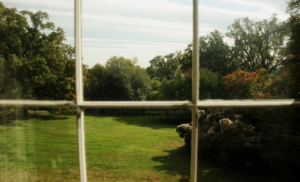Land for Sale: Inquire Within

George Washington’s ties to the land –to Mount Vernon and his other farms, and his extensive knowledge of Lord Fairfax’s extensive Virginia properties–are widely known. But far less has been written about the details of his land speculation far to the west, in the Ohio River valley extending into modern-day West Virginia, Ohio, and Kentucky. In his will, Washington left vast tracts of what was then western Virginia to the future owner of Tudor Place, Martha Peter, and her siblings and cousins. Even less has been recorded about the disposition of these inheritances.
In this deeply researched essay, Archivist Wendy Kail tracks dealings by Washington, his executors and heirs, and their agents to find the answer to a long-standing mystery about the origins of Tudor Place: What was the land sale that paid for it? Specifically, to what property did Thomas Peter refer when he said he bought Tudor Place in 1805 with a “… sum of money received by me upon the Sale of certain real property belonging to my Wife Martha Peter devised to her by her deceased relative Genl. George Washington”?
The source of this nest egg was long thought to be a bequest to Martha Parke Custis Peter from Washington, her step-grandfather, of land in what is now West Virginia. Ms. Kail’s thorough dig through archives including and well beyond the one at Tudor Place identifies that land as 1,425 acres along the Ohio River in Ravenswood, West Va. Placing them in the context of the War of 1812 and the Panic of 1819, she narrates the dealings of Peter, his sons, and their appointed agents to show definitively that Martha Peter’s “Ravenswood Tract” was ultimately sold–and then only with great difficulty–long after Tudor Place was completed.
Along the way, the author unearthed details about Washington’s attitudes, beliefs, and western travels, early American Federalism and the turmoil that surrounded its decline, and the Peters’ real estate savvy and travails. The story, with “cameo appearances” by Presidents Jefferson, Madison and Monroe; the tragic death of young Columbia Pete;, and the early Riggs Bank; has as many twists and turns as the river itself.








